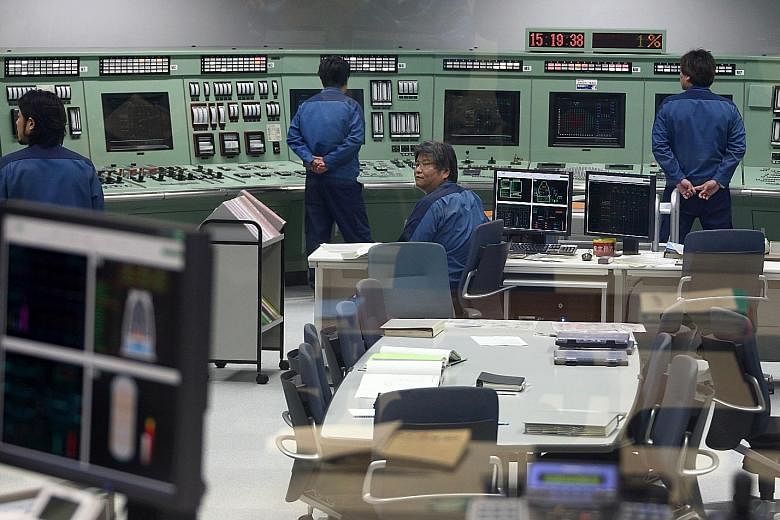TOKYO • More than 6,000 workers cycle through the world's biggest nuclear plant every day to operate and maintain a facility that has not sold a kilowatt of electricity in more than four years.
The buzz at Tokyo Electric Power's (Tepco's) Kashiwazaki-Kariwa plant plays out daily across Japan, where utilities employ thousands of workers and spend billions of dollars awaiting the green light to restart commercial operations.
With only three of the country's 42 operable reactors running, they are betting a national government committed to nuclear power will win over local officials and a wary public who do not believe enough has been done to guarantee safety after the worst meltdown since Chernobyl.
"Even though operating expenses of non-generating reactors remain high, utilities would prefer to keep them open while there is any chance they can restart," said Mr James Taverner, a Tokyo-based analyst at IHS Markit.
"Utilities have already committed significant expenditure for plants to meet new safety standards, and decommissioning costs are considerable."
The nine biggest regional utilities spent more than 1.5 trillion yen (S$20.08 billion) on their nuclear plants during the year to March, according to Bloomberg calculations based on the latest earnings reports. Over that same period, those plants accounted for just 1.1 per cent of the nation's electricity.
Nuclear-related costs accounted for 9 per cent of all operating expenses at the utilities in the previous fiscal year, according to the calculations. That includes personnel and maintenance, as well as waste disposal and contributions to the nation's nuclear damage compensation system.
The burden of paying for nuclear facilities producing little electricity has been softened by price declines in recent years for coal, natural gas and oil, which are also used as fuels for power generation.
Tepco sees itself swinging to a net loss as fossil fuel prices recover, making the restart of Kashiwazaki- Kariwa key to profitability, Mr Naomi Hirose, the company's president, said earlier this year.
Costs for operating the country's nuclear facilities were slightly higher before the March 2011 Fukushima disaster, at about 1.7 trillion yen a year, when atomic energy accounted for nearly 30 per cent of Japan's electricity mix.
Tepco estimates that restarting one of the newest reactors at Kashiwazaki-Kariwa - known as KK - would boost net income by as much as 10 billion yen a month.
The plant, the world's biggest with generating capacity of about 8.2 gigawatts, has seven reactors at a facility spread across more than 400ha and located about 217km north-west of Tokyo in the prefecture of Niigata.
Workers clad in jumpsuits and loaded down with manuals convene daily in a mock-up of the reactor control room, preparing for the restart of the plant under new safety guidelines imposed after the Fukushima meltdown.
Japan's nuclear energy industry employs more than 80,000 engineers, construction workers and operators, according to a report published by the Ministry of Economy, Trade and Industry last year.
To boost confidence in its facility's safety, Tepco has spent 470 billion yen on flood barriers, a 15m seawall and a reservoir the size of 30 Olympic-sized swimming pools to supply water in the event a reactor pump fails.
KK's restart is far from assured. The plant was forced to shut for 21 months following an earthquake in July 2007. Though some units eventually restarted, all were shuttered again after the March 2011 Fukushima accident for safety checks.
The restart of nuclear reactors is opposed by 53 per cent of Japanese and supported by just 30 per cent, according to a nationwide poll conducted earlier this year by the Mainichi newspaper.
Should KK clear the necessary regulatory, legal and political hurdles and resume operations, Tepco plans to maintain the facility's workforce at current levels, a reflection of how many workers are needed even during a period called cold shutdown.
BLOOMBERG

